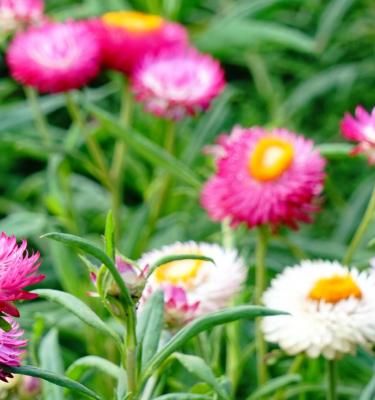

How to grow & care for Everlasting Daisies
Everlasting Daisies (Xerochrysum bracteatum) are a colourful Australian native daisy often called Strawflowers or Paper Daisies. They’ll grow as a short lived perennial or an annual in a huge range of climates (all except tropical) and soil types.
Everlasting Daisies come in a range of colours including white, yellow, pink and orange. Some cultivars are taller growing and work well amongst other plants in the garden bed, while the dwarf or compact cultivars are suited to the front of garden borders or pots.
Flowering from late spring until the first frost, Everlasting Daisies provide long-lasting colour in your garden. The papery flowers also hold their colour and shape when dried, making them beautiful for long-lasting dried flower arrangements.
Top 5 steps to growing Everlasting Daisies
- Everlasting Daisies love a full sun spot in a garden or pot
- Low maintenance plants, but for more branches and more flowers deadhead the spent flowers regularly
- Everlasting Daisies will tolerate a range of soils, but will establish best if the soil is improved with a little compost or Scotts Osmocote Compost Premium Soil Improver before planting
- Everlasting Daisies grow well in pots or containers - use a native suitable potting mix like Scotts Osmocote Native Potting Mix
- Grow Everlasting Daisies easily from seeds or potted plants. You’ll likely find a wider range of plant sizes and colours as seeds, but check your local nursery.
Shopping List
- Everlasting seeds or potted plants
- Scotts Osmocote Compost Premium Soil Improver
- Scotts Osmocote Plus Organics All Purpose (including Natives) Plant Food & Soil Improver
- Garden Shovel
- If growing in pots, you’ll need Scotts Osmocote Native Potting Mix and Scotts Osmocote Controlled Release Fertiliser: Native plus a suitable pot or container
- Defender Slug & Snail Pellets
- Defender Pyrethrum Insect Spray
Preparation
Choose a full sun location for your Everlasting Daisies, with a free-draining soil. Although they aren’t very fussy and they’ll grow in nearly every soil type, Everlasting Daisies will appreciate having some Scotts Osmocote Compost Premium Soil Improver and Scotts Osmocote Plus Organics All Purpose (including Natives) Plant Food & Soil Improver mixed through the soil before planting.
Growing from seed
It’s a good idea to sow Everlasting Daisy seeds in autumn, so they have the winter period to grow well and establish a good root system before flowering in spring and summer.
Sow Everlasting Daisy seeds directly into prepared soil or into punnets filled with Scotts Osmocote Native Potting Mix. The seeds should be sprinkled lightly onto the surface and covered lightly with more soil or potting mix. Keep them moist until they germinate.
If growing in punnets, transplant the seedlings into their final garden location once they are 5-10cm tall, allowing 30-50cm between plants depending on the size of the mature plants.
Planting in the garden
Everlasting Daisies are pretty tough and hardy, but if you live in a region with very hot summers it’s a good idea to plant them in autumn so they can establish a good root system over that first winter.
Plant your Everlasting Daisies into prepared soil - dig the hole twice as wide as the original pot and the same depth. Gently remove it from the nursery pot, tease roots if they are compact and plant into the hole. Backfill around the plant and water in well.
Mulch around the base of Everlasting Daisies to retain moisture and suppress weeds, but keep the mulch away from the main stem.
Planting in pots
Everlasting Daisies can be grown in small to medium pots or planters with good drainage - choose a pot that’s 2 to 3 times bigger than the original nursery pot or cluster several plants into a larger pot.
Fill your pot or planter with Scotts Osmocote Native Potting Mix. Gently remove the Everlasting Daisy from the nursery pot, tease the roots if they are compact and plant into the potting mix at the same height it was in the original pot. Backfill around the plant with more potting mix and water in well.
Mulch over the surface of the potting mix to help retain moisture, but keep the mulch back from the plants main stems.
Fertilising & Care
An annual feed in late winter with Scotts Osmocote Plus Organics All Purpose (including Natives) Plant Food & Soil Improver is all that Everlasting Daisies will need. Unless you have a very sandy soil, which might require a second annual fertiliser application.
Remove dead flowers throughout the flowering season and in early autumn they can be cut by up to a half to help maintain a busy growth habit.
Fertilise potted Everlasting Daisies Scotts Osmocote Controlled Release Fertiliser: Native once a year.
Pests & Diseases
Everlasting Daisies are relatively pest and disease free but aphids can sometimes be a problem, particularly on tender young shoots - spray any infestations with Defender Pyrethrum Insect Spray as needed.
Snails and Slugs also enjoy feasting on the young seedlings, so set beer traps (shallow saucers filled with beer) around young seedlings or spread some Defender Slug & Snail Pellets around your plants.



